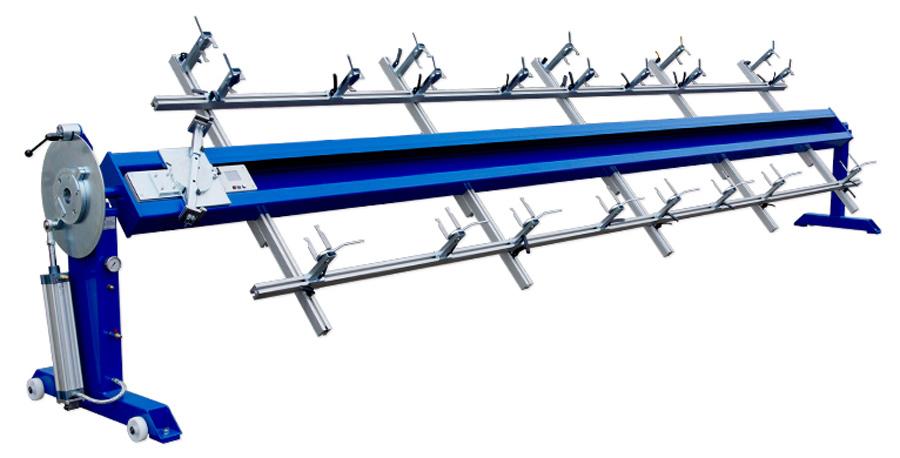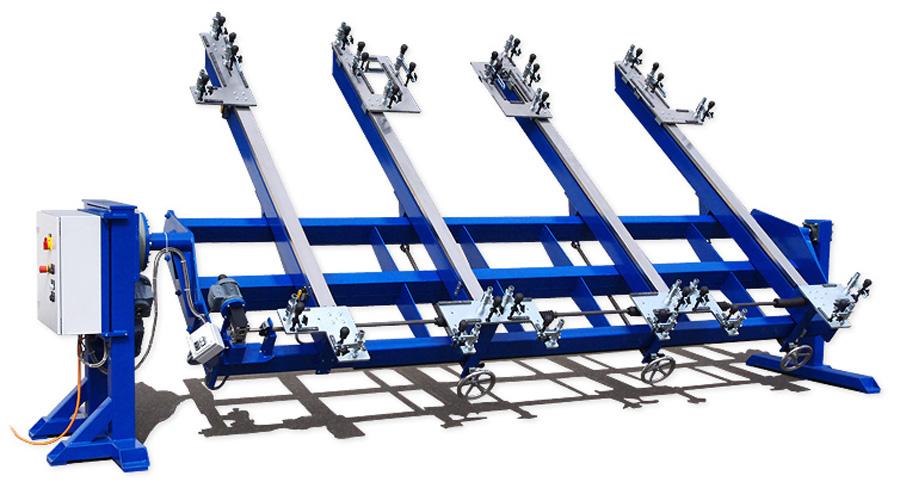President
- FMA
- The Fabricator
- FABTECH
- Canadian Metalworking
Categories
- Additive Manufacturing
- Aluminum Welding
- Arc Welding
- Assembly and Joining
- Automation and Robotics
- Bending and Forming
- Consumables
- Cutting and Weld Prep
- Electric Vehicles
- En Español
- Finishing
- Hydroforming
- Laser Cutting
- Laser Welding
- Machining
- Manufacturing Software
- Materials Handling
- Metals/Materials
- Oxyfuel Cutting
- Plasma Cutting
- Power Tools
- Punching and Other Holemaking
- Roll Forming
- Safety
- Sawing
- Shearing
- Shop Management
- Testing and Measuring
- Tube and Pipe Fabrication
- Tube and Pipe Production
- Waterjet Cutting
Industry Directory
Webcasts
Podcasts
FAB 40
Advertise
Subscribe
Account Login
Search
What to look for in railing and frame welding fixtures
- By Benjamin Howell
- August 17, 2015
- Article
- Shop Management
The best welding fixtures and jigs on the market today reduce welding time, simplify welding jobs, streamline manufacturing processes, and ultimately minimize production costs. Modern equipment also is ergonomic and designed to minimize effort.
The bottom line when looking for an ideal welding jig or fixture for welding frames or railings is that the tool should make the job easier, quicker, more accurate, more comfortable for the welder, and ultimately more cost-efficient.
Whether you are creating individual, custom-made products or multiple items produced on an assembly line, fixtures and jigs are vital to their success. It doesn't matter which industry is involved, what type of metal is welded, or how the welding job is to be carried out. Whether welding is to be manual, automated, mechanized, or even robotic, jigs and fixtures are all-important tools of the trade.
This doesn't mean that all jigs and fixtures are the same; they are not. Jigs and fixtures are created for a purpose. Furthermore, improvements in design made in the past decade put contemporary units in a class of their own, ahead of the traditional tools and welding tables that many welders and toolmakers still use today.
Choosing Welding Fixtures and Jigs for Production
Welding fixtures and jigs are found in shops that carry out machining operations. However, they also are commonly used for layout, inspection, testing, and assembly of whatever is being manufactured from metal.
While many often refer to jigs and fixtures interchangeably, the traditional difference is that although both are intended to hold and support the workpiece to be cut and welded, a jig also can be used to guide the movement of another tool, usually for cutting or drilling. The jig moves the workpiece, while the tool stays stationary.
When a fixture is used, the tool and workpiece move together. Also, fixtures have a much wider scope of application and often are identified by the function for which they are designed. So, for instance, if your business involves welding frames and railings, frame welding fixtures and railing welding fixtures are designed specifically for those operations.
Modern fixtures, some of which are suitable for all types of welding from manual to robotic, have designs that fulfill the traditional jig function as well as the function of a contemporary fixture. Such a device can be referred to as a frame welding jig or a frame welding fixture.
Traditionally, welders often used jigs and fixtures together with welding tables to support the workpiece. Today welding tables also have become increasingly sophisticated.
Welding Fixture Safety Issues
Good railing and frame welding fixtures are versatile, adaptable, and comply with precision requirements during production. They also are easy to maintain and safe to use.
When it comes to these fixtures, Occupational Safety and Health Administration (OSHA) standards are important, not only in terms of the design and installation of the equipment itself, but also in terms of welders' health and safety. Nowadays it isn't enough to simply ensure that people aren't hurt by heat, sparks, electricity, or the welding arc. Other safety issues include the need for good ergonomics, so that machine operators and welders can use equipment safely and easily without impairing physical function and ability.
OSHA notes that lifting heavy items in the workplace is one of the top causes of injury to workers. Additionally, the Bureau of Labor Statistics reported in 2001 that more than 36 percent of injuries resulting in missed workdays were the result of back and shoulder injuries. To prevent such injuries, look for fixture designs that can tilt, swivel, and enable welders to access the workpiece, especially those that are large, safely from all sides.
You also should make sure that the welding jig or fixture is strong enough to resist erosion and scratches, as well as any expected welding impact, spatter, and other potential damage caused by the welding process.
Fixtures for Railing Welding Fixtures
A well-designed fixture for railing welding (Figure 1) can cut production time significantly for banisters, straight railings, handrails, and all other ornaments and railing parts. It should be made from carbon steel, stainless steel, or aluminum, depending on which type of metal the manufacturer prefers.
To streamline welding and make production projects as simple and seamless as possible, the various bar elements for railings ideally should be placed on the frame according to how wide they are. In a design where this is possible, only the distance between upright members and the number of similar bar elements need to be entered into the input display of the machine.
It should be possible to clamp the horizontal members of the railing, including the handrail or banisters, so that they can be positioned individually along the shorter X axis, and then shifted together along the longer Y axis as a single unit. Once everything is clamped into place, the fixture can be tilted and swung into the optimum welding position to make the procedure as quick and easy as possible.
A top-of-the-range rail welding fixture has holders for handrails and belts that are made from stainless steel to conform to the demands of high-quality stainless steel railings.
Fixtures for Frame Welding
A well-designed frame welding fixture (Figure 2) allows workers to adjust and weld all sides of different-sized frames with the angles of both the upper and lower sides exposed during the process.
Mechanical clamping elements with spindle compression should be located close to weld joints, so that any joint irregularities can be sensitively compensated for. Ideally, the frame should be designed so that it can be tilted and swiveled up to 225 to 360 degrees after the components have been clamped. The degree, which depends on the size of the components, should enable the welder to work on both sides with ease.
Further, all clamping corners should be parallel and in keeping with digital accuracies, according to the digital measuring scale on the apparatus. With large, heavy frame welding fixtures and jigs, rear clamping corners should be adjustable, and the welder should be able to move each one individually.
Frame welding fixtures are available in various sizes to suit different-sized frames. Most have manual locking brakes, although a very large, heavy (such as 13 ft. by 10 ft.) frame welding fixture should have a motorized locking brake, as well as motorized load balancing. Load balancing of frames that are about 10 ft. long and anything from 5 ft. to 8 ft. wide should be pneumatic.
Today's welding fixtures are suitable for all types of welding, including robotic, and enable welders to produce top-quality work more easily and more efficiently than ever before.
About the Author
Benjamin Howell
1110 Ridgeland Pkwy, Suite 110
Alpharetta, GA 30004
770-416-7070
Related Companies
subscribe now

The Fabricator is North America's leading magazine for the metal forming and fabricating industry. The magazine delivers the news, technical articles, and case histories that enable fabricators to do their jobs more efficiently. The Fabricator has served the industry since 1970.
start your free subscription- Stay connected from anywhere

Easily access valuable industry resources now with full access to the digital edition of The Fabricator.

Easily access valuable industry resources now with full access to the digital edition of The Welder.

Easily access valuable industry resources now with full access to the digital edition of The Tube and Pipe Journal.
- Podcasting
- Podcast:
- The Fabricator Podcast
- Published:
- 04/16/2024
- Running Time:
- 63:29
In this episode of The Fabricator Podcast, Caleb Chamberlain, co-founder and CEO of OSH Cut, discusses his company’s...
- Trending Articles
How to set a press brake backgauge manually

Capturing, recording equipment inspection data for FMEA

Tips for creating sheet metal tubes with perforations

Are two heads better than one in fiber laser cutting?

Hypertherm Associates implements Rapyuta Robotics AMRs in warehouse

- Industry Events
16th Annual Safety Conference
- April 30 - May 1, 2024
- Elgin,
Pipe and Tube Conference
- May 21 - 22, 2024
- Omaha, NE
World-Class Roll Forming Workshop
- June 5 - 6, 2024
- Louisville, KY
Advanced Laser Application Workshop
- June 25 - 27, 2024
- Novi, MI




























